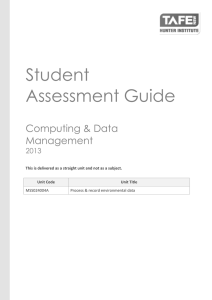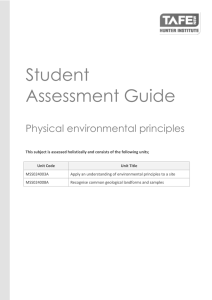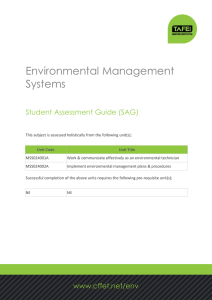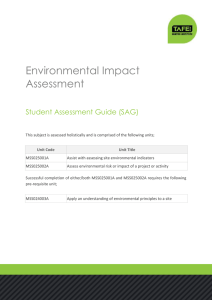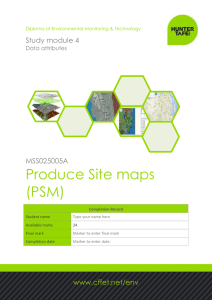Produce Site Maps (PSM) Student Assessment Guide (SAG)
advertisement
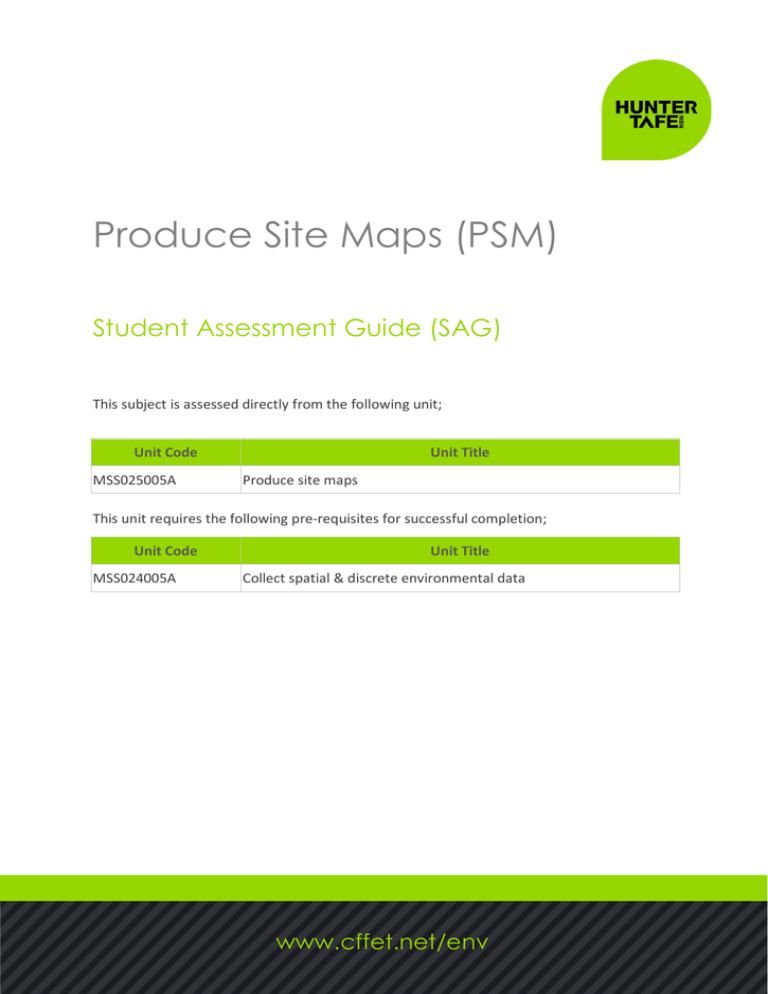
Produce Site Maps (PSM) Student Assessment Guide (SAG) This subject is assessed directly from the following unit; Unit Code MSS025005A Unit Title Produce site maps This unit requires the following pre-requisites for successful completion; Unit Code MSS024005A Unit Title Collect spatial & discrete environmental data www.cffet.net/env Produce Site Maps (PSM) SAG Subject purpose This unit of competency covers the ability to map the environmental features of a site using sketch maps, computer rendered graphics or geographic information systems (GIS) software. Personnel identify sources of existing environmental data and assess its availability/suitability, collect field data as necessary, assess data quality and format, and present data and incorporate it onto maps. Producing maps to display environmental data requires knowledge of environmental management processes, relevant legislative and regulatory requirements, mapping principles, and the use of mapping software and hardware. Personnel will require additional units of competency to manage spatial data sets or undertake complex modelling, data manipulation and analysis using GIS. Assessment Assessment for this subject will consist of assessment tasks that cover the following aspects of the production of site maps; • General theory associated with GIS applications • Sourcing & assessing spatial data • Collecting field data and ‘ground truthing’ • Preparing, manipulating and transforming data sets • Producing site maps for physical and electronic distribution There is substantial assignment and practical work required for this unit. Assessment Task Study module 1 – What is GIS? Study module 2 – Vector & raster data Study module 3 – Data attributes Study module 4 – Data capture & transformation Study module 5 – Map production Practical exercise 1 – Intro to internet GIS Practical exercise 2 – Intro to desktop GIS Practical exercise 3 – Creating a raster Practical exercise 4 – Creating vectors Practical exercise 5 – Working with layers Major Assessment 1 – Producing a site map Major assessment 2 – Publishing site maps TOTAL Weighting 5 5 5 5 5 5 5 5 5 5 25 25 100% Chemical, Forensic, Food & Environmental Technology [cffet.net/env] Version 3.0 7/05/2015 Page | 1 Produce Site Maps (PSM) SAG Subject content This subject deals with a wide variety of topics including the following aspects; ◗ Producing maps such as topographic, land use and land title maps, vegetation, soils and regional, ecosystem maps, air photos, satellite imagery and thematic maps produced using GIS software. ◗ Environmental features of sites such as, hills, waterways, vegetation and fauna, soil and rock, types, buildings, roads, utility services, property boundaries and mining leases ◗ Site information such as site or project history as well as hazards and safety risks. ◗ External sources of data from, government departments and, land title office and Valuer, General, Geoscience Australia and companies providing environmental services. ◗ Data sets such as:, textual, graphical, spatial and temporal in hard/soft copy, satellite imagery, and remote sensing data, geophysical, , ecological data and land use data. ◗ Field techniques may include:, hand mapping, comparing site features with existing site, information, collection of samples and field measurements. ◗ Field equipment and supplies such as, GPS, tapes and pegs, compass, clinometer, portable, computer, palm pilot or data logger and communication equipment ◗ Standard map elements such as, latitude and longitude, grid reference systems (old and new and, their relation to one another), north point, elevation, scale and legend ◗ Integrity of data may include accuracy, currency and completeness, scale and resolution, confidence limits for data and quality. ◗ Disparities between data sets such as, datum and projection and currency Grading The assessment for this unit/ module is recorded as a Class Mark. All assessment events used to determine your result will be locally set and locally marked. Your results will be reported as DISTINCTION, CREDIT, PASS (AC) or FAIL (NYC). To receive a particular grade you must get at least the mark shown below: Grade Class mark DISTINCTION >=83 CREDIT >=70 PASS (ACHIEVED COMPETENCY) >=50 FAIL (NOT YET COMPETENT) <50 Chemical, Forensic, Food & Environmental Technology [cffet.net/env] Version 3.0 7/05/2015 Page | 2 Produce Site Maps (PSM) SAG Delivery strategy This subject is assessed directly against the unit’s performance criteria. Unit MSS025006A Elements Performance Criteria Subject Weighting Unit Weighting All All 100 100 NOTE: The subject weighting MUST add up to 100 for the subject, but the Unit Weighting MAY NOT add up to 100 as each unit is weighted differently in each subject it is used in. Refer to cffet.net/env/assessment for further explanation. What you will need To complete this subject successfully you will need; ◗ The course notes ◗ A USB flash or thumb drive. ◗ Access to a computer with internet, email and general office programs ◗ Administrator rights to download and install free software (if required) ◗ General computer skills Where to get help Contact your teacher [www.cffet.net/env/contacts] if you run into any trouble this unit. You would be surprised how flexible we are at accommodating your needs, but communication is key. If you don’t let us know you are having trouble, we may have trouble trying to help you. Resources and references References Note that you are not required to purchase, download or read these references (unless specifically directed to by your teacher). Some of these resources might be available from your teacher or library for free. Brimicombe, A. (2010). GIS, Environmental Modelling & Engineering. 2nd Ed. Boca Raton: CRC press. DIPNR. (2004). Guideline for the preparation of Environmental Management Plans. Sydney: DIPNR. Ferrier, R. C. (2010). Handbook of Catchment Management. Oxford: Wiley-Blackwell. Newton, A. (2007). Forest Ecology and Conservation. Oxford: Oxford University Press. Schneider, R. R. (2011). MapWindow: Quick Start Tutorial. MapWindow 4.8.6. Edmonton: Free Software Foundation. Chemical, Forensic, Food & Environmental Technology [cffet.net/env] Version 3.0 7/05/2015 Page | 3 Produce Site Maps (PSM) SAG Sutherland, W. (2006). Ecological Census Techniques. 2nd Ed. Cambridge: Cambridge University Press. Sutton, T. E. (2009). A Gentle Introduction to GIS. Eastern Cape, South Africa: Chief Directorate: Spatial Planning & Information, Department of Land Affairs, Eastern Cape. Resources ◗ http://www.mapwindow.org/ ◗ http://www.qgis.org/en/site/ ◗ https://esriaustralia.com.au/about-gis ◗ https://learn.arcgis.com/ ◗ www.gislounge.com/learn-gis-for-free/ ◗ www.esri.com/training/main Assessment Submission Students are to submit all assessments by the due date to the subject teacher by email using the filename format outlined in the assessment document. Visit www.cffet.net/env/assessment for more information on submitting assessments, file names and available file extensions that you can use. Chemical, Forensic, Food & Environmental Technology [cffet.net/env] Version 3.0 7/05/2015 Page | 4
